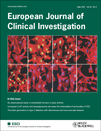An observational study of endothelial function in early arthritis
Abstract
Eur J Clin Invest 2012; 42 (5): 510–516
Background Endothelial dysfunction is present in established rheumatoid arthritis, but it is not clear at what stage of the disease this abnormality develops. We set out to determine whether endothelial damage/dysfunction is present in a group of patients with early arthritis (EA) (new onset inflammatory arthritis, EA).
Materials and methods Eighteen patients with EA, 48 healthy controls and 25 disease controls were recruited. Plasma was obtained for endothelial [von Willebrand factor (vWF) and soluble E-selectin] and angiogenesis markers (vascular endothelial growth factor and its receptor sFlt-1), adhesion molecules (intercellular adhesion molecule 1 and vascular cell adhesion molecule 1) and circulating endothelial cells (CECs, as a marker of endothelial damage). Microvascular endothelial function was assessed using laser Doppler perfusion imaging and macrovascular function using flow-mediated dilatation of the brachial artery.
Results von Willebrand factor and CECs (both P < 0·05) were significantly elevated in EA suggesting endothelial dysfunction and damage but were unrelated to classical laboratory markers of inflammation C-reactive protein, erythrocyte sedimentation rate or IL6. No other biomarkers was elevated in EA. Microvascular and macrovascular abnormalities were confined to endothelium-independent (smooth muscle cell) responses.
Conclusions Endothelial damage/dysfunction is present early in the course of inflammatory arthritis but is not directly related to inflammation markers.




